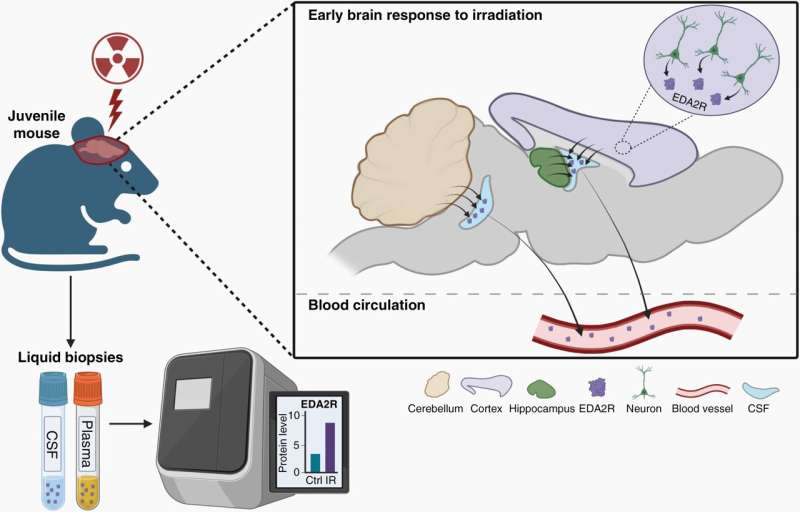
As the numbers of pediatric brain cancer survivors continue improving, the numbers of individuals developing life-long neurocognitive impairments are consequently expected to rise.
Cranial radiotherapy is standard of care for aggressive brain tumors; however, it induces debilitating neurocognitive impairments in cancer survivors, especially children. Yet, there is no established method estimating the degree of the radiotherapy-induced brain injury at completion of treatment to predict the severity of the expected neurocognitive complications.
A new study, published in Neuro-Oncology, identifies a protein called ectodysplasin A2 receptor (EDA2R) as a sensitive measure promptly reflecting the brain cell response to radiotherapy in clinical samples routinely obtained via a minimally invasive procedure, such as the in the cerebrospinal fluid and blood.
Identification of such protein would help in stratification of patients to the best available treatment option for reducing, or even preventing, the neurocognitive complications in children treated with cranial radiotherapy.
The researchers state, “We believe that these results are of translational importance as the numbers of childhood brain cancer survivors continue rising, and this success is paralleled with an increase the in numbers of individuals expected to carry life-long neurocognitive impairments, representing an emerging concern in neuro-oncology.
“Yet there is no available tool estimating the degree of the radiotherapy-induced brain injury at a very early stage after completion of the treatment course.
“Cancer treatments are lifesaving, but substantially reduce the quality of life of the survivors and little is known about the causes behind this. With the current and future advances in the research tools, we could narrow down this gap-of-knowledge and develop means and therapies to prevent the unwanted side effects of the cancer treatment, so that the cancer survivors have a better life after curing the disease.
“These findings are setting the stage for future clinical studies in patients to correlate the levels of EDA2R in the cerebrospinal fluids or blood samples with the magnitude of the later developed neurocognitive impairments.
“If the correlation is evident, EDA2R would hence be a valuable biomarker for prediction of the severity of the expected IR-induced neurocognitive sequalae at a very early stage after cranial radiotherapy.
“This may, therefore, aid in stratification of patients to the best available treatment option for reducing, or even preventing, the neurocognitive complications in children treated with cranial radiotherapy.”
More information:
Alejandro Lastra Romero et al, EDA2R reflects the acute brain response to cranial irradiation in liquid biopsies, Neuro-Oncology (2024). DOI: 10.1093/neuonc/noae077
Citation:
Investigating how to prevent unwanted side effects of cancer treatment in children (2024, May 6)
unwanted-side-effects-cancer-treatment.html
.
. The content is provided for information purposes only.
